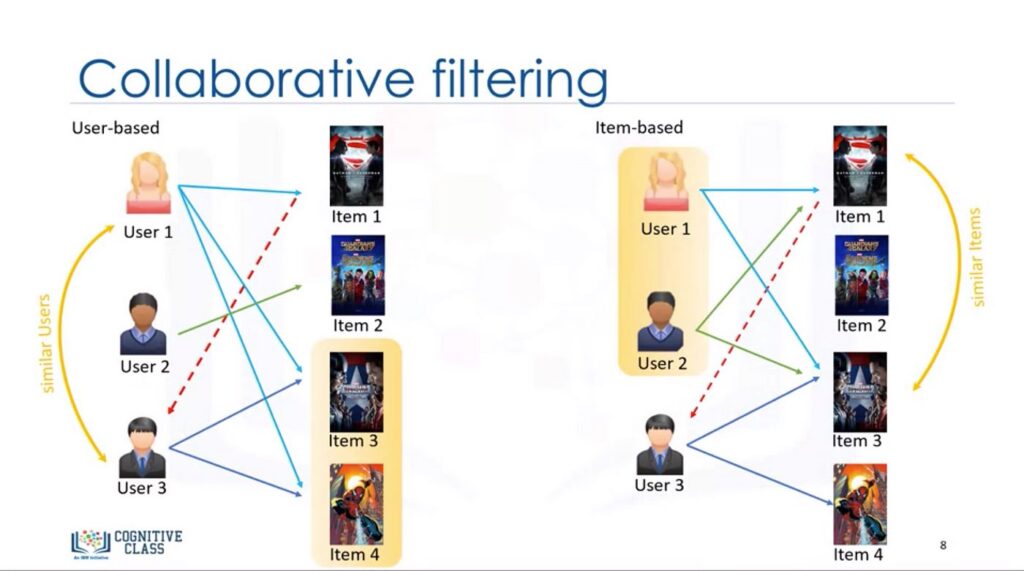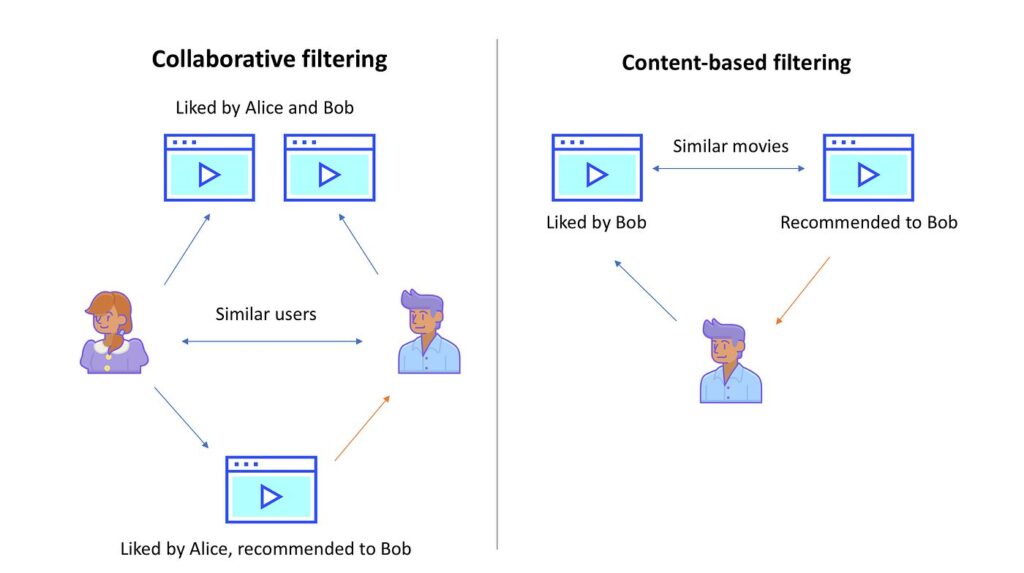Collaborative filtering is a classification of software that focuses on making predictions about user preferences based on collective data from multiple users. It is a popular technique used in recommendation systems to suggest products, movies, music, and other content to users based on what others with similar tastes have liked or purchased.
Collaborative filtering is a type of software that recommends items based on user preferences. It compares your choices with others, helping to suggest things you might like, such as movies or products.
In this article, we will discuss “Collaborative Filtering Is A Classification Of Software That”.
Table of Contents
What Is Collaborative Filtering Software?
Collaborative filtering software recommends items based on user behavior. It compares your preferences with others to suggest products, movies, or music you might like, making personalized recommendations based on shared interests.
How Collaborative Filtering Works?

Collaborative filtering operates by analyzing the interactions between users and items. It identifies patterns and similarities in user behavior to generate recommendations. There are two main approaches:
1. User-Based Collaborative Filtering:
This approach recommends items to a user based on what similar users have liked. If User A and User B have similar tastes, the system will recommend to User A the items that User B has enjoyed.
2. Item-based Collaborative Filtering:
In this approach, the system recommends items similar to those that a user has already liked. For example, if you liked a particular book, the system will suggest other books that are similar in content or style.
Types Of Collaborative Filtering:
There are several types of collaborative filtering, each with its strengths and weaknesses:
1. Memory-Based Collaborative Filtering:
This method relies on the entire dataset to make predictions. It’s straightforward but can become inefficient with large datasets.
2. Model-Based Collaborative Filtering:
Model-based methods use machine learning techniques to predict user preferences. These models are trained on historical data and are more scalable than memory-based methods.
3. Hybrid Methods:
Hybrid methods combine memory-based and model-based approaches, often resulting in more accurate predictions by leveraging the strengths of both.
Applications Of Collaborative Filtering:
Collaborative filtering is widely used across various industries. Some of the most common applications include:
1. E-Commerce Recommendations:
Online retailers like Amazon use collaborative filtering to suggest products to users based on their purchase history and the behavior of similar users.
2. Streaming Services:
Platforms like Netflix and Spotify use collaborative filtering to recommend movies, TV shows, and music based on users’ past interactions.
3. Social Media And Content Curation:
Social media platforms use collaborative filtering to curate content, suggesting posts, videos, and articles that align with users’ interests.
Advantages Of Collaborative Filtering:
Collaborative filtering offers several benefits that make it a popular choice for recommendation systems:
1. Personalization:
It tailors recommendations to individual users, improving user satisfaction and engagement.
2. Scalability:
Collaborative filtering can handle large amounts of data, making it suitable for platforms with millions of users.
3. Simplicity:
The basic principles of collaborative filtering are easy to understand and implement, especially with user-friendly libraries and tools.
Challenges And Limitations:

Despite its advantages, collaborative filtering has some challenges:
1. Cold Start Problem:
When a new user or item is introduced, there needs to be more data to make accurate recommendations.
2. Sparsity Issue:
In large datasets, users often interact with only a small fraction of items, making it difficult to find patterns.
3. Privacy Concerns:
Using personal data to make recommendations can raise privacy issues, especially if users need to be made aware of how their data is used.
Improving Collaborative Filtering Techniques:
To address the challenges, several techniques can be used to improve collaborative filtering:
1. Data Preprocessing:
Cleaning and organizing data can enhance the accuracy of recommendations by reducing noise and inconsistencies.
2. Incorporating Contextual Information:
Adding contextual information like time, location, and user demographics can lead to more relevant recommendations.
3. Using Hybrid Models:
Combining collaborative filtering with other recommendation methods, such as content-based filtering, can provide more robust results.
Collaborative Filtering Vs. Content-Based Filtering:
While both are popular recommendation techniques, they differ in approach:
1. Key Differences:
Collaborative filtering relies on user behavior, while content-based filtering focuses on the attributes of the items themselves.
2. Advantages And Disadvantages Of Each:
Collaborative filtering is great for discovering new items but struggles with new users or items. Content-based filtering doesn’t have a cold start problem but can be limited by the content it knows about.
Real-World Examples Of Collaborative Filtering:
Many companies successfully use collaborative filtering to enhance user experiences:
1. Amazon’s Recommendation System:
Amazon’s recommendation engine suggests products based on what similar customers have purchased, driving significant sales.
2. Netflix’s Movie Recommendations:
Netflix uses collaborative filtering to recommend movies and shows that align with users’ viewing history and preferences.
3. Spotify’s Music Suggestions:
Spotify’s Discover Weekly playlist is a prime example of collaborative filtering in action, offering users a personalized mix of songs each week.
Implementing Collaborative Filtering In Your Project
If you’re looking to implement collaborative filtering, consider the following:
1. Choosing The Right Algorithm:
Selecting the appropriate algorithm depends on your data, resources, and specific needs.
2. Necessary Tools And Libraries:
Popular tools like Apache Mahout, Surprise, and TensorFlow can help you build collaborative filtering systems.
3. Best Practices For Implementation:
Ensure data quality, regularly update models, and continuously monitor performance to get the best results.
Collaborative Filtering Algorithms:
Several algorithms are commonly used in collaborative filtering:
1. K-Nearest Neighbors (Knn):
KNN is a simple and effective method for finding similar users or items in a dataset.
2. Matrix Factorization:
Matrix factorization techniques like Singular Value Decomposition (SVD) are powerful for reducing data dimensionality and making predictions.
3. Deep Learning Approaches:
Deep learning models can capture complex patterns in user behavior, leading to more accurate recommendations.
Collaborative Filtering Is A Classification Of Software That Qui:

Collaborative filtering is a type of software that recommends items based on user preferences. It predicts what you might like by comparing your choices with others who have similar tastes and making personalized suggestions.
Is Collaborative Filtering Classification Or Regression?
Collaborative filtering is a classification method. It groups users with similar preferences to make predictions about what you might like, rather than estimating a specific numerical value like regression does.
Which Activity Demonstrates The Use Of Collaborative Filtering?
An example of collaborative filtering is when Netflix recommends movies based on what you and others with similar tastes have watched. It predicts your preferences by comparing your viewing history with others.
FAQs:
1. What Is The Difference Between Collaborative Filtering And Recommendation Systems?
Collaborative filtering is a method used within recommendation systems to predict user preferences, whereas recommendation systems can use various techniques, including collaborative filtering.
2. How Does Collaborative Filtering Handle New Users Or Items?
This is known as the cold start problem. Solutions include using hybrid models or incorporating additional data sources.
3. Is Collaborative Filtering Suitable For Small Datasets?
Collaborative filtering works best with large datasets. In small datasets, it may struggle to find meaningful patterns.
4. Can Collaborative Filtering Be Used For Non-Recommendation Tasks?
Yes, it can be applied to tasks like clustering, anomaly detection, and even fraud detection.
5. What Are The Ethical Considerations In Using Collaborative Filtering?
Ethical considerations include user privacy, data security, and ensuring that recommendations do not reinforce harmful biases.
Conclusion:
Collaborative filtering is a powerful tool for personalized recommendations, used widely in e-commerce, streaming, and social media. However, it faces challenges like the cold start problem and privacy concerns. Improving techniques and combining methods can enhance its effectiveness, making it a versatile and valuable approach for various applications.
